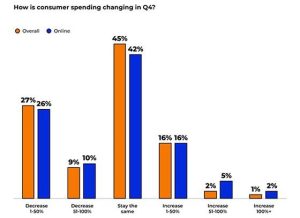Here are the valuable metrics beyond opens and clicks that can impact your business.
Metrics like clicks and opens are crucial for measuring campaign performance. But other metrics have a bigger impact on your business and marketing strategy.
“It’s not just about getting those easy-access metrics that are available in your email service provider’s dashboard,” said Kath Pay, founder and CEO of boutique consultancy Holistic Email Marketing at The MarTech Conference. “Business-oriented ones can actually help you to identify whether you’re moving the needle or not.”
Here are six email marketing metrics that cut to the heart of marketing and business objectives.
Conversion rate
Looking at the conversion rate helps build a bigger picture about the customer journey beyond opens and clicks.
“The conversion rate, of course, happens more often than not on the landing page,” Pay explained. “So it’s taking account of the email journey, but also the landing page where the conversion happens — because we all know that conversions more often than not don’t actually happen in the email.”
Conversion rates are typically calculated by dividing the number of conversions on your site by the number of visitors. In order to measure the impact of email campaigns on the overall business, marketers should include the entire customer journey in their calculation, which includes email.
Value of an email address
Marketers should also measure the value that each email in their database is worth.
This will help decide if paid media campaigns on other channels are worth it. Email campaigns don’t cost as much as ad campaigns on digital or traditional media. So, this makes the value of emails an important metric to know, because of the potentially high return on investment.
Also, if the goal of a campaign on other media is to get customers to sign up with their email, then the value of the emails helps measure the overall value of the campaign.
To calculate the value of an email address, you need to first know how long the lifecycle of the emails are. Once you know that, take the annual email revenue and multiply it by the number of years of the email cycle. Then, divide that number by the average list size during the year.
Customer behavior behind the campaign
Sometimes email campaigns impact customer behavior, but not in the way you intended. So, pay close attention to how customers behave when they receive emails. For instance, they might open your brand’s email, and instead of clicking through to a website, they might search in Google about your product first, before deciding to purchase. They might even visit a competitor. Or, they see your company in the subject line or address and go straight to Google without opening.
“So they’re not opening and they’re not clicking, but they’re actually still taking action,” said Pay. “It’s not necessarily the action that you’re counting on them taking, i.e. clicking, so what we find out is that email is generally under-attributed.”
Getting a better hold on the other customer behaviors that your email campaigns influence will help make a better case for the importance of email campaigns.
Return on investment (ROI)
As mentioned above, email is a very low-cost marketing channel that can yield big results. Therefore, ROI is an important metric to make that business case to your colleagues.
“If you need more budget or if you’re wanting to change [email marketing] providers, you often need to build this business case,” said Pay.
To calculate email ROI, take total sales driven by email, subtract costs of the email campaigns, then divide that number by the costs. Multiplying that number by 100 gives you the percentage.
Open-reach and click-reach
“Open-reach and click-reach measure how well you’re engaging your audience on a non-campaign basis,” said Pay. “There’s more to marketing and measuring the success of your email program than just reporting on campaigns.”
These two metrics are more subscriber-based metrics, she added. They can be measured month-to-month, quarterly or however it works best for the organization.
Measuring the clicks and opens for a specific campaign, or for a month-long period, can show how effective the campaigns were in generating meaningful results.
Open-reach and click-reach show a cumulative effect over a long period. They add up the customers who didn’t click on an email during one campaign but did so in another. This way, the percentage creeps closer to 100% throughout the span of time you decide to measure.
It gives you a better measure of the overall impact of your email program, than metrics for specific campaigns.
Customer lifetime value
Customer lifetime value (CLV) is about as far from a campaign metric as one can get, Pay said.
However, email campaigns can play an important role in acquiring new customers. Therefore the overall value of those customers can be very relevant to acquisition.
To determine CLV, calculate average customer spend over the course of the year, then multiply it by the number of years the average customer spends with your brand.
For all of these important metrics, keep in mind that they will change over time. So they can be used for benchmarking and showing how the business is improving overall.
Most important for email marketers, it also shows how email campaigns can impact the business over time.
“Everything that you’re looking at here, you could be benchmarking this,” said Pay. “This is what it is now, but we’re going to be improving our email program, we’re going to be improving our acquisition. We’re going to be using a whole heap of different tactics, trying different offers — to be able to get that increased customer lifetime value.”
The post 6 email metrics to help reach marketing goals and make business decisions appeared first on MarTech.
MarTech(21)
Report Post








